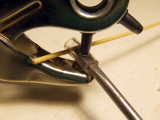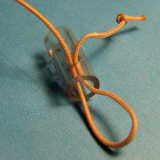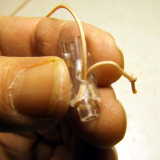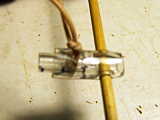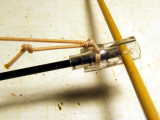Insert a dowel or rod through the first hole, just to help keep it aligned while you punch the second hole. You want to punch a second hole through one side only, not all the way through. In this photo I'm using a flat screw driver blade to keep it from punching through both sides. I probably should have used something softer, like a thin piece of wood, so as to protect the cutting edge on the leather punch.
This second hole goes about 1/3 of the way from the other end.
Feed a loop of the tension line through the second hole and out the near end.
Push one end of the thinner piece of tube 2/3 of the way inside the larger tube, making sure that the loop of tensionline stays on the opposite side of the thin tube. Even though the nominal diameters suggest that it should slide in easily, you may need to use needle-nosed pliers or tweezers to push the tube in.
(Sorry, this photo is a bit blurry, but you can still make out what is going on.)
Tie an overhand slipknot to secure the loop of tension line, and pull it snug inside the large tube. Even with the spreader bar removed, the loop will not fall out.
A dowel or rod in the cross hole prevents the thin tube from going too far in while you are working on it.
Here it is with a 2.5 mm carbon fiber rod inserted. I think it will be plenty tight enough for 2.5 mm rods, and a 1/8" (3.175 mm) dowel is so snug that you cannot pull the fitting off. It just gets tighter, so you have to push it off. I purposely cut the thin tubing a bit long, because it's easier to insert rods that way.
Now all I need to do is build a kite that actually uses it.
I have no idea yet how durable it is. My biggest worry is that the tension line might stretch the hole, or even tear it through to the end of the larger tube.
